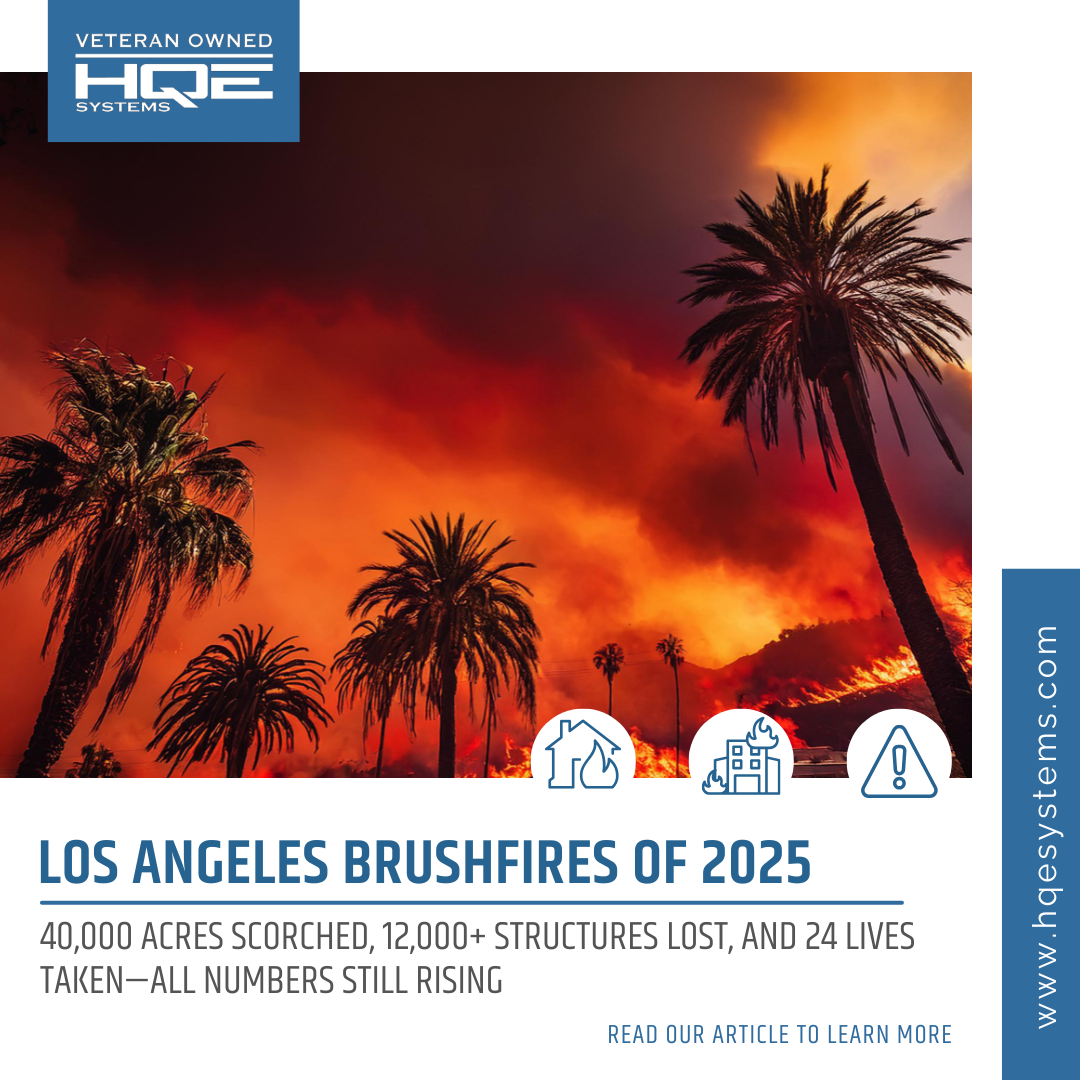Introduction: The Fiery Reality of Southern California
The air was thick with smoke, and the once-vibrant skies over Los Angeles turned a foreboding orange. Families scrambled to pack their lives into suitcases as ash rained down, and sirens pierced the chaos. The wildfires of 2025 struck with a fury no one could have imagined.
In just days, 98 wildfires erupted across Southern California, consuming over 40,000 acres and destroying more than 12,000 structures. Communities reeled from the devastation as emergency responders launched 13,926 missions to contain the infernos. The Palisades and Eaton fires, the most destructive of the blazes, claimed at least 24 lives, with fatalities still under investigation.
This is the story of chaos, heartbreak, and resilience in the face of nature’s fury.
Section 1: The Wildfires at a Glance
As dawn broke on January 7, 2025, Southern California was already under siege. Winds howled at over 100 miles per hour, carrying embers from one dry hillside to the next, igniting a chain reaction of devastation. The Palisades and Eaton fires led the charge, becoming the largest and most destructive wildfires in Los Angeles’ history. However, they were not the only infernos wreaking havoc.
The Palisades Fire: A Wealthy Neighborhood in Ashes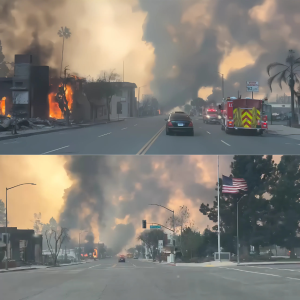
The Palisades Fire erupted mid-morning on January 7, swiftly engulfing the affluent communities of Pacific Palisades and parts of Malibu. Fueled by Santa Ana winds and parched vegetation, the fire spread across 20,000 acres within 48 hours. By January 9, containment hovered at a mere 8%, leaving firefighters struggling against unpredictable winds and unrelenting flames (CBS News, 2025).
This fire left behind a path of unprecedented destruction, with thousands of homes turned to ash. Celebrities such as Mel Gibson, Paris Hilton, and James Woods were among those whose properties were reduced to rubble. For many residents, decades of memories vanished in an instant, leaving an indelible scar on the community.
The Eaton Fire: Destruction in the Heart of Los Angeles
While the Palisades Fire ravaged the western hills, the Eaton Fire carved a path of devastation through the Angeles National Forest and into densely populated neighborhoods such as Altadena and Pasadena. The fire ignited on the evening of January 7, near a transmission tower in Eaton Canyon, and quickly consumed 13,700 acres.
The cause of the fire is still under investigation, with early reports suggesting a potential connection to utility infrastructure failures. Santa Ana winds, combined with dry brush and drought conditions, transformed the fire into a catastrophic event. By January 9, the Eaton Fire was only 3% contained, and thousands of residents faced evacuation orders as flames threatened to overrun their communities (Washington Post, 2025).
Other Fires Across the Region
Southern California faced a staggering 98 wildfires during this period, several of which caused significant damage:
- Hurst Fire: This blaze erupted in Sylmar, burning 771 acres and threatening neighborhoods before reaching 37% containment.
- Kenneth Fire: Located on the Los Angeles-Ventura County border, this fire consumed nearly 1,000 acres, with containment efforts reaching 35%. Investigators suspect arson as a potential cause.
- Lidia Fire: Breaking out in the mountainous Acton area, the Lidia Fire scorched 395 acres. Containment reached 75% thanks to the swift efforts of firefighters.
Many smaller fires, such as the Sunset and Woodley fires, were successfully contained, but not before adding to the chaos and stretching emergency resources thin (CBS News, 2025).
The Human Toll
The combined destruction of these fires is staggering. Over 40,000 acres have been burned, and preliminary assessments report over 12,000 structures destroyed. Tragically, at least five lives have been lost, pending final coroner confirmation, with countless others injured. Evacuation orders impacted over 153,000 residents, many fleeing with only the clothes on their backs as flames approached their neighborhoods.
Challenges in Containment
The sheer magnitude of the fires overwhelmed local firefighting efforts. The Santa Ana winds, combined with the region’s record-breaking drought, created an environment ripe for disaster. Firefighters faced logistical challenges, including water pressure issues, limited resources, and the difficulty of navigating steep terrain in areas like Eaton Canyon.
Containment progress was slow, with unpredictable wind patterns constantly shifting fire lines. Despite deploying over 13,926 emergency responses, firefighters struggled to gain control of the Palisades and Eaton fires, which remained only partially contained days after igniting (CBS News, 2025).
A Glimpse at the Scale of Destruction
The combined damage from these wildfires has made them among the most destructive in California’s history. According to early Disaster Inspection and Notification System (DINS) assessments, the fires may result in insured losses exceeding $8 billion. This staggering figure highlights the economic and emotional toll on residents, many of whom face the daunting task of rebuilding their lives.
For more detailed updates and maps of the affected areas, visit CBS News.
Section 2: The Causes Behind the Flames
The devastating wildfires that ravaged Los Angeles in early 2025 were fueled by a perfect storm of natural and human factors. While California is no stranger to wildfires, this particular series of events underscored the growing complexity of wildfire causation in a rapidly changing environment.
The Role of Nature: Santa Ana Winds and Drought Conditions
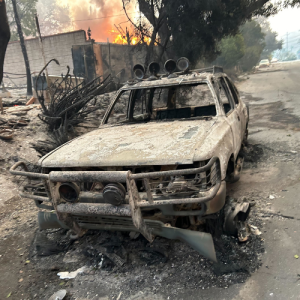 Southern California’s notorious Santa Ana winds are infamous for their ability to transform a small spark into a raging inferno. These dry, powerful gusts—clocking in at over 100 mph during this firestorm—swept across the region, fanning flames and propelling embers over long distances. The winds not only accelerated the spread of the fires but also made firefighting efforts perilous, with shifting fire lines and unpredictable flare-ups (BBC News, 2025).
Southern California’s notorious Santa Ana winds are infamous for their ability to transform a small spark into a raging inferno. These dry, powerful gusts—clocking in at over 100 mph during this firestorm—swept across the region, fanning flames and propelling embers over long distances. The winds not only accelerated the spread of the fires but also made firefighting efforts perilous, with shifting fire lines and unpredictable flare-ups (BBC News, 2025).
Compounding the problem was the region’s exceptional dryness. Los Angeles had received just 0.16 inches of rain since October 2024, leaving vegetation brittle and primed to ignite. This prolonged drought, coupled with record-high temperatures, created tinderbox conditions across the region. According to climate experts, these factors are part of a broader pattern driven by climate change, which has intensified the frequency and severity of wildfires in California (BBC News, 2025).
Human Factors: Infrastructure Failures and Arson
While nature laid the groundwork, human activity played a pivotal role in igniting and exacerbating the wildfires. In the case of the Eaton Fire, early investigations suggest that electrical infrastructure may have been a contributing factor. Reports indicate that live power lines remained active in areas of high wildfire risk, despite protocols for de-energization during red-flag warnings. Transmission equipment near Eaton Canyon showed signs of stress, and eyewitness accounts described sparks and flashes at the fire’s origin point (Washington Post, 2025).
Utility companies like Southern California Edison (SCE) are facing scrutiny for their handling of power shutoffs during extreme fire conditions. Although portions of the affected area were de-energized, evidence from grid-monitoring technology shows that some homes near the canyon retained power when the fire started. This raises questions about the effectiveness and consistency of wildfire mitigation efforts by utility providers (Washington Post, 2025).
Arson is another suspected cause of some of the smaller fires, such as the Kenneth Fire, which investigators believe may have been deliberately set. A man was arrested on suspicion of attempting to start a fire near one of the burn areas, although no charges have been filed as of yet. Intentional acts like these amplify the chaos during an already volatile situation and divert critical resources away from containment efforts (BBC News, 2025).
The Climate Connection
Experts widely agree that climate change has exacerbated the conditions leading to larger and more destructive wildfires. Prolonged droughts, increased temperatures, and the phenomenon known as “climate whiplash”—extreme shifts between wet and dry periods—have created an abundance of dry vegetation across California. These conditions ensure that when a fire ignites, it grows faster and spreads farther than in the past (BBC News, 2025).
A Dangerous Combination
The Los Angeles wildfires of 2025 highlight the deadly convergence of natural forces and human error. While nature provided the winds and drought-stricken fuel, human factors such as utility failures and potential arson set the stage for an unprecedented disaster. Addressing these dual causes will be essential in preventing similar tragedies in the future.
Section 3: The Devastating Impact
The wildfires that swept through Los Angeles in 2025 have left behind devastation that goes far beyond charred landscapes. From heartbreaking human losses to widespread structural damage and environmental degradation, the impact of this disaster is profound and far-reaching.
The Human Toll
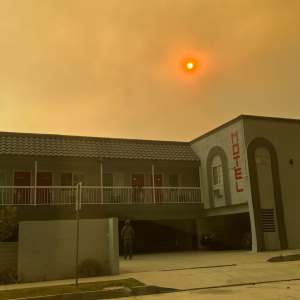 The fires claimed at least 24 lives, with fatalities still under investigation, leaving families and communities grappling with sudden loss and places to go to. Hundreds of people suffered injuries, primarily burns and smoke inhalation, and hospitals were stretched thin as they worked to treat victims. Emergency responders conducted over 13,926 missions, risking their own lives to rescue those trapped by the fast-moving flames.
The fires claimed at least 24 lives, with fatalities still under investigation, leaving families and communities grappling with sudden loss and places to go to. Hundreds of people suffered injuries, primarily burns and smoke inhalation, and hospitals were stretched thin as they worked to treat victims. Emergency responders conducted over 13,926 missions, risking their own lives to rescue those trapped by the fast-moving flames.
For the 153,000 people forced to evacuate, the experience was harrowing. Families fled through smoke-filled streets, many unsure if they would ever see their homes again. One resident described the scene as “apocalyptic,” recalling the orange glow of flames in their rearview mirror as they drove away with only moments to spare. Evacuation centers quickly reached capacity, adding to the emotional strain of displacement for thousands.
Structural Damage and Financial Losses
The fires obliterated over 40,000 acres and destroyed more than 12,000 structures, including homes, schools, and businesses. Entire neighborhoods in Pacific Palisades, Altadena, and Pasadena were reduced to rubble. The Palisades and Eaton fires alone account for much of this destruction, leaving once-thriving communities unrecognizable (CBS News, 2025).
Preliminary disaster assessments estimate insured losses to exceed $8 billion, making these fires among the costliest in California’s history. The destruction of commercial buildings has also left thousands unemployed, compounding the economic fallout for affected families and local economies.
Environmental Consequences
Beyond the immediate human and financial costs, the environmental impact of the wildfires is staggering. Millions of tons of carbon dioxide were released into the atmosphere, contributing to the global climate crisis and exacerbating the conditions that fueled these fires.
The thick smoke created hazardous air quality across Southern California, triggering respiratory problems, especially among vulnerable populations like children, the elderly, and those with preexisting conditions. Wildlife habitats in areas such as the Angeles National Forest were destroyed, displacing countless animals and threatening species already on the brink of extinction.
The long-term environmental damage is equally concerning. Without vegetation to stabilize the soil, the risk of mudslides and flash floods will increase dramatically during future rainy seasons. These secondary disasters could bring further destruction to already vulnerable communities.
A Community Shattered
The aftermath of the wildfires will take years to fully address. Thousands of residents are now homeless, and entire neighborhoods must be rebuilt from the ground up. For many, the emotional scars of fleeing the flames and losing everything will be harder to heal than the physical destruction.
A Catalyst for Change
The devastation caused by the Los Angeles wildfires serves as a stark reminder of the urgent need for better preparedness, infrastructure resilience, and environmental stewardship. As the region begins to rebuild, these lessons must guide the path forward to prevent such a catastrophe from happening again.
For ongoing updates and resources for affected communities, visit CBS News.
Section 4: Assessing Preparedness and Response
The Los Angeles wildfires of 2025 posed unprecedented challenges to emergency responders, who worked tirelessly to safeguard lives and property under extreme conditions. While their efforts were heroic, the scope of the fires underscored several logistical and operational challenges that offer opportunities for learning and improvement.
Challenges in Firefighting Efforts
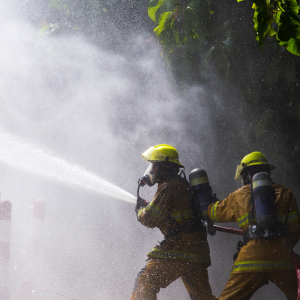 One significant challenge was the availability and management of water resources. In some areas, the simultaneous use of multiple fire engines caused temporary dips in water pressure. While this issue was resolved quickly, it highlighted the need for ongoing evaluation of water distribution systems to ensure adequate support during peak firefighting operations (BBC News, 2025).
One significant challenge was the availability and management of water resources. In some areas, the simultaneous use of multiple fire engines caused temporary dips in water pressure. While this issue was resolved quickly, it highlighted the need for ongoing evaluation of water distribution systems to ensure adequate support during peak firefighting operations (BBC News, 2025).
The terrain and weather conditions added to the difficulty. Fires like the Eaton blaze, which burned through steep areas of the Angeles National Forest, were particularly hard to access. Coupled with the strong, unpredictable Santa Ana winds, these conditions made containment efforts dangerous and complex.
Despite these challenges, firefighters received reinforcement from mutual aid agreements with neighboring regions, ensuring additional personnel and equipment were deployed to assist. This collaboration was instrumental in managing resources across the 98 active wildfires reported during the period.
Communication During Evacuations
Communication played a crucial role in the emergency response, ensuring residents in danger were informed and evacuated safely. Over 153,000 people were evacuated, but the scale of the crisis created moments of confusion. A mass alert was mistakenly sent to individuals outside immediate evacuation zones, prompting frustration and uncertainty for those not directly impacted (CBS News, 2025).
Officials moved quickly to address the error, clarifying the situation and reinforcing the importance of leaving emergency notifications enabled on devices. This incident highlighted the delicate balance between issuing timely warnings and maintaining accuracy, emphasizing the importance of advanced, targeted notification systems.
Building on Strengths
The response to these wildfires demonstrated the resilience of the Los Angeles community and the dedication of emergency teams. While resource limitations and communication challenges were present, the collaboration among agencies and swift problem-solving minimized the potential for greater losses.
Future improvements could focus on enhancing resource coordination, refining mass notification systems, and expanding training for responding to complex disasters. By addressing these areas, Los Angeles can continue to build a more robust emergency preparedness and response framework.
Section 5: Technology as a Solution
 The devastating Los Angeles wildfires of 2025 underscore the need for advanced technologies to improve emergency response and preparedness. HQE Systems offers a suite of innovative tools, including the SAFE Network, SMART Alert Software, and advanced fire detection systems, to empower communities and first responders during critical moments.
The devastating Los Angeles wildfires of 2025 underscore the need for advanced technologies to improve emergency response and preparedness. HQE Systems offers a suite of innovative tools, including the SAFE Network, SMART Alert Software, and advanced fire detection systems, to empower communities and first responders during critical moments.
The SAFE Network: Reliable Communication in Any Crisis
The SAFE Network is a dependable public safety communication platform that remains operational even in the most challenging conditions. With up to 10 days of battery backup, the system ensures uninterrupted communication without relying on AC power, cellular networks, or the internet. By delivering geo-targeted alerts and integrating seamlessly with sirens, strobes, and digital displays, the SAFE Network minimizes confusion and ensures vital messages reach the right people at the right time.
SMART Alert Software: AI and ML Transforming Emergency Management
HQE’s SMART Alert Software takes emergency response to the next level by integrating AI (Artificial Intelligence) and ML (Machine Learning) capabilities. This unified platform connects electronic, indoor, and outdoor alert systems, enabling consistent and multilingual communication during crises.
AI in SMART Alert Software automates alerts by analyzing real-time sensor data from fire, weather, and other safety systems. These algorithms detect patterns, predict evolving threats, and send automated notifications to affected areas. For example, during the Los Angeles wildfires, AI-driven automation could have ensured faster evacuation alerts based on real-time fire spread data.
Machine learning enhances the system’s efficiency by learning from past incidents to improve future response strategies. Data from previous wildfires can refine evacuation planning, optimize resource allocation, and ensure more precise targeting of alerts. By incorporating AI and ML, SMART Alert Software ensures faster, smarter, and more effective responses to dynamic emergencies.
Fire Detection Systems: Early Warning Saves Lives
HQE’s fire detection systems use IoT-enabled sensors to monitor heat, smoke, and air quality changes. These sensors provide instant alerts to emergency managers, enabling swift responses before fires escalate. When integrated with the SAFE Network and SMART Alert Software, these systems create a powerful safety net that ensures early warnings and coordinated actions.
By deploying fire detection systems in high-risk areas, such as the Angeles National Forest, authorities can identify threats earlier and reduce the potential for widespread devastation.
A Future Built on Innovation
With the SAFE Network, SMART Alert Software, and fire detection systems, HQE Systems provides a comprehensive approach to emergency management. These tools not only enhance communication and situational awareness but also lay the foundation for safer, more resilient communities.
Conclusion: Turning Tragedy Into Resilience
The Los Angeles wildfires of 2025 remind us of the urgent need for advanced technology and proactive preparedness. HQE Systems’ innovative solutions, including the SAFE Network, SMART Alert Software, and fire detection systems, empower communities to act swiftly and effectively. Together, we can build a safer, more resilient future.
HQE Systems is a certified Veteran Owned Company. For more information about HQE Systems Inc. and its emergency management, electronic security, and integration solutions, please visit www.hqesystems.com.

Contact: David Ditto (Early Warning Systems Subject Matter Expert)
Email: David.Ditto@hqesystems.com
Phone Number: (843) 872-7020
____________________
HQE Systems, Inc. | HQE is a Minority-Owned Service Disabled Veteran Owned Small Business (SDVOSB) providing full solutions for: Mass Notification Systems, Electronic Security Systems, Software Development Services, Contract Support, and Prototyping Services. As a brand-agnostic solutions provider, HQE prides itself in providing the BEST solution for the project. HQE possesses over 30+ factory certifications and reseller licenses to ensure our clients receive the highest quality service at the ideal budget. HQE can provide full design, installation, integrations, upgrades, and long-term maintenance support for any size and scope project.

